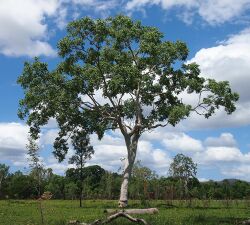Biology:Eucalyptus platyphylla
| Poplar gum | |
|---|---|

| |
| Scientific classification | |
| Kingdom: | Plantae |
| Clade: | Tracheophytes |
| Clade: | Angiosperms |
| Clade: | Eudicots |
| Clade: | Rosids |
| Order: | Myrtales |
| Family: | Myrtaceae |
| Genus: | Eucalyptus |
| Species: | E. platyphylla
|
| Binomial name | |
| Eucalyptus platyphylla | |
Eucalyptus platyphylla, commonly known as poplar gum or white gum,[2] is a species of medium-sized tree that is endemic to Queensland. It has smooth. powdery bark, heart-shaped, egg-shaped to almost round leaves, flower buds in groups of seven, white flowers and conical to hemispherical fruit.
Description
Eucalyptus platyphylla is a tree that typically grows to a height of 20 m (66 ft) and forms a lignotuber. It has smooth, powdery, pale pink to greenish white bark. Young plants and coppice regrowth have deltoid leaves that are 90–200 mm (3.5–7.9 in) long and 60–165 mm (2.4–6.5 in) wide. Adult leaves are the same shade of dull greyish green on both sides, heart-shaped to egg-shaped or almost round, 50–210 mm (2.0–8.3 in) long and 35–120 mm (1.4–4.7 in) wide on a petiole 25–70 mm (0.98–2.76 in) long. The flower buds are arranged in leaf axils in groups of seven on an unbranched peduncle 3–8 mm (0.12–0.31 in) long, the individual buds sessile or on pedicels up to 6 mm (0.24 in) long. Mature buds are oval to almost spherical, 6–9 mm (0.24–0.35 in) long and 5–7 mm (0.20–0.28 in) wide with a rounded to conical operculum. Flowering occurs from June to October and the flowers are white. The fruit is a woody, conical to hemispherical capsule 3–6 mm (0.12–0.24 in) long and 6–10 mm (0.24–0.39 in) wide with the valves near rim level or slightly protruding.[2][3]
Taxonomy and naming
Eucalyptus platyphylla was first formally described in 1859 by Ferdinand von Mueller in Journal of the Proceedings of the Linnean Society, Botany from material collected near the Burdekin River.[4][5] The specific epithet (playtphylla) is from ancient Greek words meaning "flat", "wide" or "broad" and "-leaved", referring to the broad leaves.[2]
Distribution and habitat
Poplar gum is mostly found within 100 km (62 mi) of the coast in soils that often remain west for long periods. It occurs from Horn Island in the Torres Strait to near Rockhampton.[2][3]
Conservation status
This eucalypt is listed as "least concern" under the Queensland Government Nature Conservation Act 1992.[6]
See also
References
- ↑ "Eucalyptus platyphylla". Australian Plant Census. https://biodiversity.org.au/nsl/services/apc-format/display/105551.
- ↑ Jump up to: 2.0 2.1 2.2 2.3 "Eucalyptus platyphylla". Euclid: Centre for Australian National Biodiversity Research. https://apps.lucidcentral.org/euclid/text/entities/eucalyptus_platyphylla.htm.
- ↑ Jump up to: 3.0 3.1 Chippendale, George M.. "Eucalyptus platyphylla". Australian Biological Resources Study, Department of the Environment and Energy, Canberra. https://profiles.ala.org.au/opus/foa/profile/Eucalyptus%20platyphylla.
- ↑ "Eucalyptus platyphylla". APNI. https://id.biodiversity.org.au/instance/apni/455839.
- ↑ von Mueller, Ferdinand (1859). "Monograph of the eucalypti of tropical Australia". Journal of the Proceedings of the Linnean Society, Botany 3: 93. https://www.biodiversitylibrary.org/item/8353#page/97/mode/1up. Retrieved 2 December 2019.
- ↑ "Eucalyptus platyphylla". The State of Queensland Department of Environment and Science. http://wetlandinfo.ehp.qld.gov.au/wetlands/ecology/components/species/?eucalyptus-persistens.
Wikidata ☰ Q7213013 entry
 |


